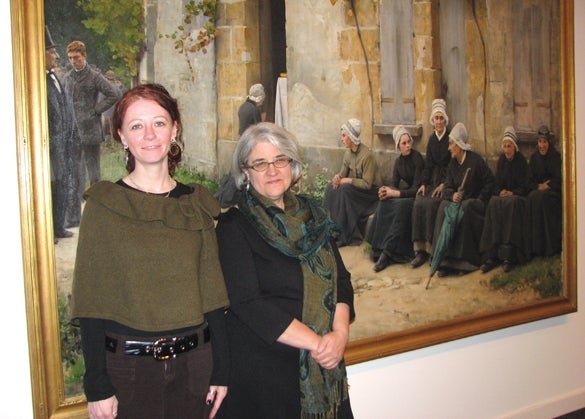Nearly 25 years into its existence, the Danforth Museum of Art in Framingham is considering where its future lies.
Katherine French, director of the museum, is determined that the nonprofit, or small business as she likes to call it, will thrive over the next few years, and she’s marshalling Harvard Business School resources and others to help her do so.
Community Roots
The museum is planning its future, either at its current location on Union Street near downtown, or if necessary, at another location within Framingham or somewhere else in MetroWest if need be.
“Philosophically, historically and emotionally we need to be here, but it does no good if we stay here and end up going out of business,” French said, who joined the museum in 2005.
The Danforth Museum is somewhat unique as area museums go because it was started through a grassroots group more than 30 years ago and it continues to have no endowment fund.
The museum, which opened in 1975, has been a tenant-at-will for $1 a year with the city of Framingham as its landlord, which owns the 100-year-old former school on Union Street. The building needs a lot of maintenance — an estimated $5 million — just to come up to code. The litany of physical problems includes a 100-year-old boiler on its last legs, a deteriorating roof and asbestos wrapping much of the piping.
A makeover or addition to the existing building would take considerably more money, in the neighborhood of $15 to $24 million. Those numbers cover an array of options, which French has recently begun talking about publicly, including an addition, as well as a redone foyer and school area. But, French stressed, no final decisions have been made.
French and the museum’s board realize that Framingham doesn’t have money to fix up the building either, given the state of the economy and the continuing cuts to local aid. But she is resolved to do better by the museum, its art and its patrons.
“The economy is behaving in ways that no one expected it to. Any other time we would have announced a major capital campaign,” French said.
The museum was awarded a $37,500 matching grant from the Massachusetts Cultural Commission’s Cultural Facilities Fund to cover a building feasibility study that is cataloguing the building’s physical problems, including an asbestos inventory, along with architectural options for the building if money were raised for capital improvements and an audience capability study. The museum raised the other $37,500 in matching funds mostly from its directors.
Anna Beha Architects of Boston is heading the feasibility study, and has subcontracted to Shawmut Construction of Boston and Axiom Partners of Wakefield for construction and asbestos determinations.
French has talked to the Harvard Business School, which has two programs that will help the Danforth: the Harvard Business School’s Community Action Partners and a benchmarking study of the museum that will be done by school’s graduate students. The Community Action Partners puts together a team of HBS alumni that helps a nonprofit with its strategic planning process.
Since the museum does not have an endowment, it must exist on the admission fees, class tuition and corporate and private donations to fund its $1.4 million-plus budget. It cut $60,000 in expenses to balance its budget this year. “We have to crack that nut every year and we need to be solvent at the end of the year,” French said.
It is important to lead the organization through the decision-making process around the museum’s future financially, physically and as an advocate and educator of American contemporary art, she said.
“In my experience consultants are either really, really good or just OK and they don’t tell you anything you don’t already know. These people tell me things I don’t know,” French said about the HBS alumni group. Many have a development background, and as the architect and construction companies discuss costs, the alumni point out how much money needs to be raised over and above the cost of improvements or additions. “It’s nothing you’d ever find in a textbook.”
For his part, Richard Sayre, who leads the HBS Community Action Partners group working with the museum said the group is impressed with the focus and publicity that French has been able to generate.
Noting that the museum started off as a very small effort, he pointed to the substantial growth it has seen, with its focus on the expression of contemporary art.
“They have been extremely efficient with their resources,” he said.
The help from HBS alumni does not include any help with fundraising, but French already has that covered.
Rick Kiernan, owner of Integrity Fundraising of Atlanta, Ga., is conducting a feasibility study that involves talking to about 50 stakeholders in the museum to review its options.
The faltering economy may actually be driving people to the museum, according to French.
The museum is seeing up to 100 visitors a day on the weekend, when previously they would see at most 30 visitors. One day this winter they had 200 visitors.
The museum’s art school saw 3,300 students, including adults and children, go through its classes in from Sept. 1, 2007 to Aug. 31, 2008, a 33 percent increase of 822 students in two years.
“We’re seeing exponential growth in people paying to come in the door,” French said.
“A lot of people have told us this year that they’ve decided not to go away for a vacation or that they can’t afford to go to the theater or eat dinner out once a week, but they can join the museum and come whenever they want.”
Read more

